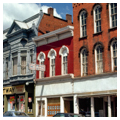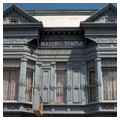An exuberant galvanized and cast-iron facade purchased from a manufacturer of storefronts distinguishes this two-and-a-half-story brick building. Manufacturers of metal fronts advertised them as being more elaborate than masonry fronts and a fraction of their cost. Pedimented paired oriel windows ornamented with diamond-pressed panels, swags, medallions, and roping are separated by engaged pilasters in the pressed-metal design of the upper story. Cast-iron pilasters, dentils, and sills were installed in the first-floor Queen Anne front.
The front probably was purchased from George L. Mesker and Company of Evansville, Indiana. Mesker's 1904 catalog of iron storefronts boasted, “With our system of marking each piece, our details and descriptions, any carpenter can set our fronts and make a first class job, at a cost of one-half the cost of setting the front of any other manufacturer.” An inscription identifying the owner tops the cornice of the paired pedimented windowed facade. The largest galvanized front in Michigan is on the Chippewa Hotel on Mackinac Island, installed around 1904 by George L. Mesker and Company for George T. Arnold.














